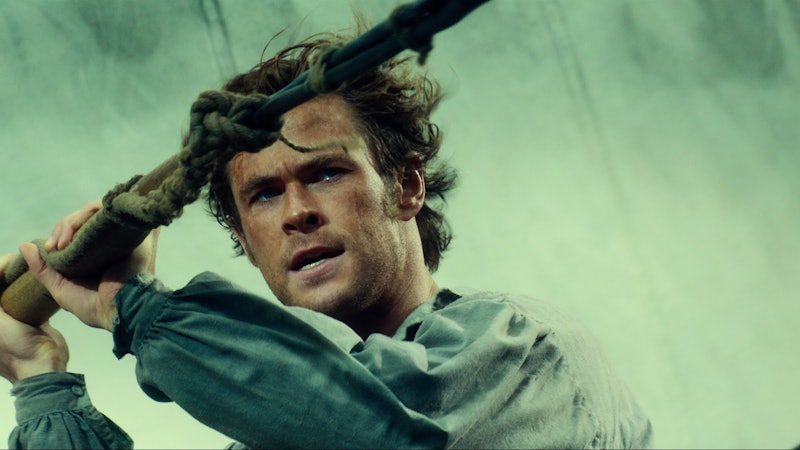
As soon as I heard about In the Heart of the Sea 's whale hunting premise, I was nervous. As a whale lover looking for an end to whaling, which sadly still happens even in 2015, I was worried the film (set in 1820 and based on the true story that Moby Dick was inspired by) would leave audiences sympathizing with the whalers. Chris Hemsworth certainly has a huge fan base and I feared those fans would identify with the struggle of the (attractive) stranded whaler over the rights of the animals his character hunted. Fortunately, I am pleased to report that In the Heart of the Sea doesn't glorify whaling and instead turns the greedy whalers into the villains of the film rather than demonizing the whale who sank the Essex.
This choice was deliberate on the part of those involved in the film. "We really wanted, were concerned to not have a pro-whaling movie by any means," Hemsworth told the New York Daily News. "We wanted to depict the brutality of it, but also show some doubt and some remorse in what these men were doing, that this was the industry at the time."
I understand that in the past, these whalers felt they needed the whale oil for light and didn’t have alternatives, but the fact that the movie was made in 2015 had me concerned. We now know the disastrous results of the whaling industry of yore. Where there used to be hundreds of thousands of whales in the oceans, the population has now been drastically reduced thanks to the huge numbers killed in the whaling of the 19th and 20th centuries.
Nature magazine reports that in the 20th century from 1900 to 1999, "nearly 3 million cetaceans were wiped out in what may have been the largest cull of any animal — in terms of total biomass — in human history." The magazine also notes that the numbers have never recovered. Sperm whales, prized for the spermaceti wax in their heads, now live at what some have estimated is one third their pre-whaling numbers, and 90 percent of the blue whale population was killed off.
Those kinds of numbers are staggering, which is why it was so important that In the Heart of the Sea not glorify whaling, no matter what era it was set in. The cast of characters in the film don't know yet of the damage to come, and they are driven by the promise of wealth and the thrill of the chase, with little regard for the animals' lives — at first. Here's where the film departs from real history by showcasing a humanity that is not often associated with whale hunters. [Spoilers ahead.]
When Hemsworth's Owen Chase (who is based on a real person) has a chance to later kill the "white whale" that destroyed their ship and killed many of their crew, he resists. The movie shows him ready to throw the harpoon until the giant mammal swims alongside his rowboat and looks him in the eye. Many have detailed what it's like to look a whale in the eye, and the amount of understanding that is reflected in their vision. Ocean photographer Bryant Austin described in his book Beautiful Whale the time it happened to him, and how it inspired an entire collection of photos that he quit his job and sold his house to spend time creating.
Her eye was fully illuminated by the late afternoon sunlight coming over my shoulder. Taking her in as she slowly glided by, I saw for the first time the calm, mindful expression of a whale’s eye looking into my own eyes. In that moment, she was completely transformed and was no longer a whale; that word suddenly became meaningless. In this overwhelming sensation of unfamiliarity, I saw clearly what had been missing in the thirty-five years of whale photography: Intimate moments such as these documented at full scale and on the whales’ terms. Moments that reveal the calm, mindful gaze of a whale.
That moment is clear in the film as Hemsworth looks into the eye of the whale and chooses not to kill the great creature. (A dramatized version of the event was chosen as the film's poster image.)
When he's finally rescued and arrives home, he's horrified to see that the whaling industry's greed has caused officials to gloss over the Essex's sinking, so that people will believe whaling is safe. However, the most important creative license the movie took comes next, when Chase retires from whaling, instead becoming a merchant sailor. In real life, Chase remained a whaler for many years.
And, so, whale lovers, while the movie's initial hunt scene is hard to watch, its message is ultimately one that will move you and leave you satisfied that these tales of cruelty can be retold in a day and age that imparts a lesson learned from the past's mistakes. The movie changed Chase’s fate to drive home a strong point: That humanity for your fellow creatures is more important than their dollar value.
Image: Warner Bros. Pictures (2)